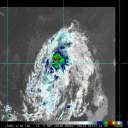Show Selection:
|
#986244 (Received by flhurricane at: 10:45 PM 14.Oct.2019)
TCDAT5
Tropical Depression Fifteen Discussion Number 2
NWS National Hurricane Center Miami FL AL152019
1100 PM AST Mon Oct 14 2019
The depression has become somewhat less organized this evening. A
band of deep convection has developed over the far northern portion
of the circulation, but there is little convection over the
remainder of the large circulation. A recent partial ASCAT-C
overpass suggests that the low-level center is located well
southwest of the mid-level turning noted in infrared satellite
pictures, and although the scatterometer did not sample the entire
circulation, it appears that the 30-kt initial intensity may be
generous.
The depression is moving northwestward (320 degrees) at about
9 kt. While there is a chance that the center will re-form farther
north near the mid-level center and area of deep convection, the
overall motion of the system is expected to be northwestward
during the next day or two around the southwestward periphery
of a deep-layer ridge over western Africa. The models are in
generally good agreement on this overall scenario, but since the
system is still in the formative stage there is a fair amount of
cross-track spread. After 48 hours, the cyclone should turn toward
the left as it weakens and is steered by the low-level flow. The
new NHC track forecast has been adjusted north of the previous
track, but is not quite as far north as the ECMWF and the
multi-model consensus.
Deep convection is likely to return overnight during the typical
nocturnal convective maximum, and low shear and warm SSTs along the
path of the cyclone favor strengthening during the next day or so.
The large and sprawling structure of the system, however, suggest
any intensification should be slow to occur, and the new NHC
intensity forecast has been reduced slightly from the previous
advisory. By 36 hours, increasing southwesterly shear and cooler
SSTs are expected to cause the cyclone to weaken and the system is
forecast to degenerate into a remnant low in 2 to 3 days. The NHC
intensity forecast most closely follows the statistical SHIPS/LGEM
guidance.
Regardless of whether the depression becomes a tropical storm or not
before passing near the Cabo Verde Islands, the primary threat from
this system is the potential for locally heavy rainfall and flash
flooding in those islands.
FORECAST POSITIONS AND MAX WINDS
INIT 15/0300Z 14.5N 20.8W 30 KT 35 MPH
12H 15/1200Z 15.5N 21.7W 30 KT 35 MPH
24H 16/0000Z 16.8N 22.9W 35 KT 40 MPH
36H 16/1200Z 18.1N 23.9W 35 KT 40 MPH
48H 17/0000Z 19.3N 24.8W 30 KT 35 MPH
72H 18/0000Z 21.6N 27.5W 20 KT 25 MPH...POST-TROP/REMNT LOW
96H 19/0000Z...DISSIPATED
$$
Forecaster Brown |



